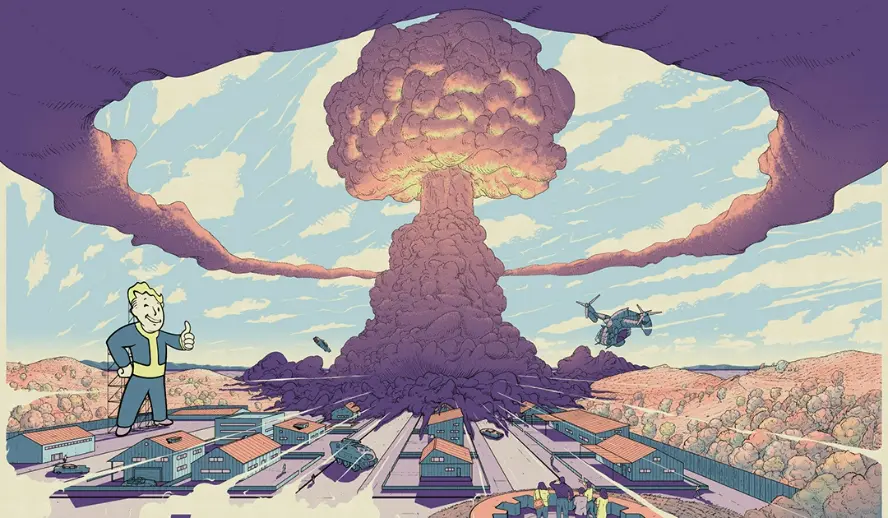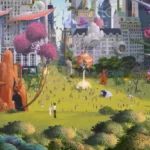Table of Contents

Post-apocalyptic settings offer a haunting reflection of today’s world, exploring how our fears, choices, and vulnerabilities shape the future and echo through society’s ruins.
One of the most popular subgenres of Science Fiction has to be Post-Apocalyptic Fiction. From ‘The End of the World’ to most recently the Emmy Award nominee ‘Fallout‘. Neil Gaiman once said “Fiction is the lie that tells the truth” and when it comes to Apunkalypse fiction, nothing could be further from the truth. These stories often reflect our real-world anxieties, particularly those rooted in the catastrophic events of the 20th century.
Things to do:
- Subscribe to The Hollywood Insider’s YouTube Channel, by clicking here.
- Limited Time Offer – FREE Subscription to The Hollywood Insider
- Click here to read more on The Hollywood Insider’s vision, values and mission statement here – Media has the responsibility to better our world – The Hollywood Insider fully focuses on substance and meaningful entertainment, against gossip and scandal, by combining entertainment, education, and philanthropy.
The Little Boy and Fat Man atomic bombs were dropped on Hiroshima and Nagasaki in August 1945, and Japan surrendered in September of the same year, bringing WWII to an end. The bombs devastated the cities, killing between 150,000 and 246,000 people. In response, The Bulletin of the Atomic Scientists created The Doomsday Clock in 1947, to indicate how close humanity is to self-destruction with Midnight representing total destruction. This year that clock was set to 90 seconds to midnight. Those threats humanity once feared in fiction are now the closest to our reality today. These apocalyptic scenarios aren’t just imaginative anymore.
WATCH THE TRAILER of the Film and the Revolution: ‘Can I Go Home Now?’
The Children Around the World Continue to Ask the question
Haunting Visions of Tomorrow
There have been multiple takes on how the end of the world is going to arrive. In ‘9’ machines revolt, and in ‘The Last of Us’ a parasitic outbreak, but there are some that hit closer as they’re surprisingly accurate. These scenarios are to our reality like seen in ‘Mad Max’ or ‘I Am Legend’.
‘Fallout’ is a prime example of this. Even though the television shows us the actual bombs dropping as well as the 2070s decade that preceded the attack via flashbacks. The series mainly takes place in the year 2296, which the canon positions it 9 years after the events of ‘Fallout 4’ and 219 years after the bombings. Most of the conflict’s information can be found in the games and their lore, particularly ‘Fallout 3‘, set in the ruins of Washington, D.C.
Since the first game, we’ve been told that the conflict began with the 25-year-long Resource Wars around 2052 for the heavenly reliable petroleum and uranium. A year later a socially transmitted disease known as The New Plague emerged, slowly killing around 20,000 people in the United States. As the war went on these resources rapidly decreased prompting China to invade Alaska in the winter of 2066 as an attempt to secure the last remaining resources on Earth, kicking off the Sino-American War where the US introduced the iconic Power Armor a year later.
Related article: – Want GUARANTEED SUCCESS? Remove these ten words from your vocabulary| Transform your life INSTANTLY
Related article: Analyzing ‘Mad Max: Fury Road’ – All Hail Charlize Theron’s Imperator
In an effort to maintain control over the Alaskan Pipeline, the United States began annexing Canada in 2072. The conflict lasted for over a decade until February 2077, when a US secret experimental research into an artificial mutation virus known as Forced Evolutionary Virus leaked to the public. This was the final straw for China as biological weapons were outlawed, starting The Great War.
Even though The Fallout Universe diverges from our own sometime after 1945, these circumstances are actually plausible. The infamous competition for limited resources can be seen in our reality with the battle for dwindling fossil fuels still going strong, countries battling for control over energy sources as the climate crisis worsens, even the advancements in military technology are surprisingly similar despite the investment in nuclear energy that occurred in the Fallout universe around the 50s. Narratives like this force us to confront the harsh realities of our future, urging reflection on the fragility of our current path and encouraging action. Fostering a deeper awareness of the consequences of our actions.
Faded Blueprints
Post-apocalyptic narratives allow us to witness those moments after the collapse of civilization. Some like ‘Dune’ display civilizations thousands of years in the future, others such as ‘A Quiet Place: Day One’ show us the immediate aftermath of the end of the world. These destinies are able to teach us the critical need for foresight and thoughtful decision-making that comes from understanding the fragile nature of our world.
Alfonso Cuarón‘s ‘Children of Men‘ offers one unique take on the genre. Here a sudden and unexplained global infertility caused widespread despair, economic chaos, a loss of meaning in life, and the total collapse of social order. As a result, this world saw the rise of a totalitarian regime in the UK where refugees are heavily oppressed, worsening the increasing social unrest.
Related article: EVOLUTION: Every Ryan Gosling Role From 1995 to 2020, All Performances Exceptionally Poignant
Related article: EVOLUTION: Every Henry Cavill Role From 2001 to 2021, All Performances Exceptionally Poignant
Related article: Fantasy as a Mirror: Using Fantasy to Explore Reality’s Issues
Unsurprisingly, over the past half-century, the world has witnessed a sharp decline in fertility rates in virtually every country on Earth, especially when considering the social and economic changes throughout these times. In addition, infertility affects 1 in 6 people globally, and with refugee-based conflicts in the last couple of years, this outcome slowly approaches our reality. This allows viewers to reflect on contemporary issues such as increasing political radicalism, fear of outsiders, and the decline of social conventions.
Of course, not all aftermaths are bleak. Some like in ‘Station Eleven’ where after a pandemic that kills most of the world’s population, the small number of survivors focus on art, storytelling, and the preservation of past knowledge. Others like ‘WALL-E’ show us a future where Earth has a possibility to be restored. These remind us of the importance of preservation and hope, urging humanity to act now to secure a better future.
Crucible of the Soul
In recent eras Television and Cinema have been used as mediums for more mental and spiritual-driven themes. The post-apocalyptic genre is no exception to this, mostly seen merged with other genres such as Psychological Horror or Fantasy. Visions like such let us explore the psychological and metaphysical tolls that set fates adrift.
This can be seen in ‘The Road‘. Exploring the human psyche in great depth, beginning with the trauma of witnessing widespread death through the eyes of a father tasked with protecting his child from a hopeless world. The film provides viewers with a unique perspective on how such scenarios affect young people, while also demonstrating resilience and hope through a father-son bond. Reminding us of the value of human connections and morality.
Related article: Understanding the Star Wars Timeline
Related article: A Tribute to Francis Ford Coppola: One of Cinema’s Unforgettable Directors | ‘Megalopolis’, ‘The Godfather’ & More
Related article: #metoo Revolution: Powerful Questions That Need Answers
Related article: FACT-CHECKED Series: Timothee Chalamet and 32 Facts about The Young Superstar
Related article: Netflix’s ‘Sweet Tooth’ Tells a Dark Tale of Hope and Wonder Amidst The Apocalypse
‘Sweet Tooth’, portrays a world in which despite the devastation brought on by the virus there remains compassion and affection. Gus’s innocence and optimistic outlook on life allow the piece to contrast with other Doomsday dramas. Highlighting that sympathy and empathy are important values amidst a crisis.
Although the post-apocalypse genre started as a fictional what-if, the genre slowly paved a starting point for creators to address the issues of our time. By exploring societal anxieties and fears about large-scale destruction, they challenge us to grapple with uncomfortable truths, encouraging introspection and analyzation of the current state of our world. Fostering critical thought through adversity.
By Mario Martinez Ignacio
Click here to read The Hollywood Insider’s CEO Pritan Ambroase’s love letter to Cinema, TV and Media. An excerpt from the love letter: The Hollywood Insider’s CEO/editor-in-chief Pritan Ambroase affirms, “We have the space and time for all your stories, no matter who/what/where you are. Media/Cinema/TV have a responsibility to better the world and The Hollywood Insider will continue to do so. Talent, diversity and authenticity matter in Cinema/TV, media and storytelling. In fact, I reckon that we should announce “talent-diversity-authenticity-storytelling-Cinema-Oscars-Academy-Awards” as synonyms of each other. We show respect to talent and stories regardless of their skin color, race, gender, sexuality, religion, nationality, etc., thus allowing authenticity into this system just by something as simple as accepting and showing respect to the human species’ factual diversity. We become greater just by respecting and appreciating talent in all its shapes, sizes, and forms. Award winners, which includes nominees, must be chosen on the greatness of their talent ALONE.
I am sure I am speaking for a multitude of Cinema lovers all over the world when I speak of the following sentiments that this medium of art has blessed me with. Cinema taught me about our world, at times in English and at times through the beautiful one-inch bar of subtitles. I learned from the stories in the global movies that we are all alike across all borders. Remember that one of the best symbols of many great civilizations and their prosperity has been the art they have left behind. This art can be in the form of paintings, sculptures, architecture, writings, inventions, etc. For our modern society, Cinema happens to be one of them. Cinema is more than just a form of entertainment, it is an integral part of society. I love the world uniting, be it for Cinema, TV, media, art, fashion, sport, etc. Please keep this going full speed.”
More Interesting Stories From The Hollywood Insider
– Want GUARANTEED SUCCESS? Remove these ten words from your vocabulary| Transform your life INSTANTLY
– A Tribute to Martin Scorsese: A Complete Analysis of the Life and Career of the Man Who Lives and Breathes Cinema
– Do you know the hidden messages in ‘Call Me By Your Name’? Find out behind-the-scenes facts in the full commentary and In-depth analysis of the cinematic masterpiece
– A Tribute To The Academy Awards: All Best Actor/Actress Speeches From The Beginning Of Oscars 1929-2019 | From Rami Malek, Leonardo DiCaprio To Denzel Washington, Halle Berry & Beyond | From Olivia Colman, Meryl Streep To Bette Davis & Beyond
– In the 32nd Year Of His Career, Keanu Reeves’ Face Continues To Reign After Launching Movies Earning Over $4.3 Billion In Total – “John Wick”, “Toy Story 4”, “Matrix”, And Many More

Mario Martinez Ignacio is a writer from Mexico City. As a child, he spent most of his free time deep-diving into online wikis, which sparked a passion for lore and worldbuilding. Driven by his love for writing, Mario obtained a BFA in Dramatic Writing at the Savannah College of Art and Design in 2024. With the objective of inspiring others, he fuses writing and education to create narratives that entertain while igniting curiosity and fostering new perspectives, one word at a time.








